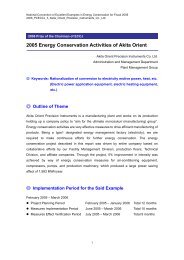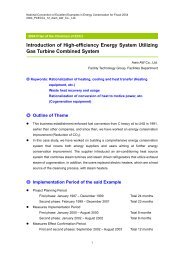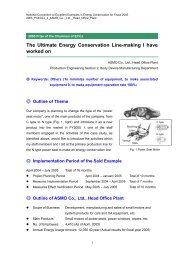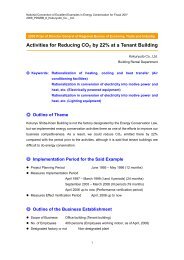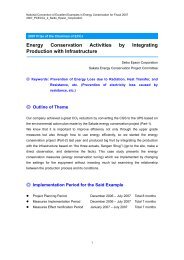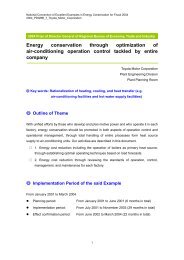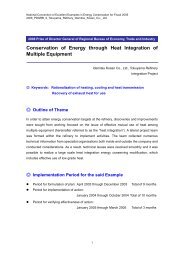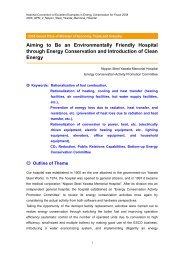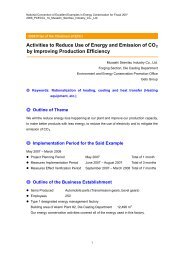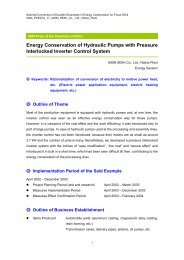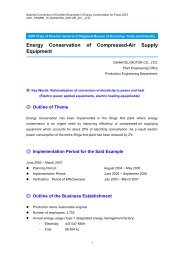Activity to reduce unit consumption of compressed air by its supply in ...
Activity to reduce unit consumption of compressed air by its supply in ...
Activity to reduce unit consumption of compressed air by its supply in ...
Create successful ePaper yourself
Turn your PDF publications into a flip-book with our unique Google optimized e-Paper software.
National Convention <strong>of</strong> Excellent Examples <strong>in</strong> Energy Conservation for Fiscal 2005<br />
2005_PCECCJ_7_Nissan_Mo<strong>to</strong>r_Co._Ltd._Oppama_Plant<br />
2) Current situation <strong>of</strong> supplied pressure<br />
Trend accord<strong>in</strong>g <strong>to</strong> the record <strong>of</strong> tube end pressure for each process is shown <strong>in</strong> Fig.5 and<br />
trend accord<strong>in</strong>g <strong>to</strong> the record <strong>of</strong> header pressure is shown <strong>in</strong> Fig.6.<br />
These suggest the follow<strong>in</strong>g:<br />
[1] When production is f<strong>in</strong>ished, there is a temporary and sharp rise <strong>of</strong> pressure.<br />
[2] When production is not done, pressure is higher than when production is done.<br />
[3] Tube end pressure differs from process <strong>to</strong> process, and <strong>in</strong> some systems, it is higher<br />
than the specified pressure.<br />
[4] Header pressure fluctuates widely and is higher than the expected value.<br />
Tube end<br />
pressure<br />
(2) Analysis <strong>of</strong> Current Situation<br />
Pressure rises after production is f<strong>in</strong>ished<br />
Production end Production start<br />
Pressure is high dur<strong>in</strong>g non-production<br />
hours<br />
Pressure drops when l<strong>in</strong>es are started<br />
Fig.5 Current situation <strong>of</strong> the tube end pressure<br />
Header pressure<br />
Maximum<br />
value<br />
Average<br />
M<strong>in</strong>imum<br />
value<br />
Fig.6 Current situation <strong>of</strong> header pressure fluctuation<br />
The correlation between <strong>compressed</strong> <strong>air</strong> flow rate and pressure at the start and end <strong>of</strong><br />
production is shown <strong>in</strong> Fig.7. At the end <strong>of</strong> production, flow rate <strong>of</strong> <strong>compressed</strong> <strong>air</strong> drops<br />
rapidly and the pressure rises temporarily. When production is not done, pressure is higher<br />
than when production is done because flow rate is less. In addition, at the start <strong>of</strong> production,<br />
flow rate <strong>of</strong> <strong>compressed</strong> <strong>air</strong> rises rapidly and the pressure drops temporarily. As described<br />
5



